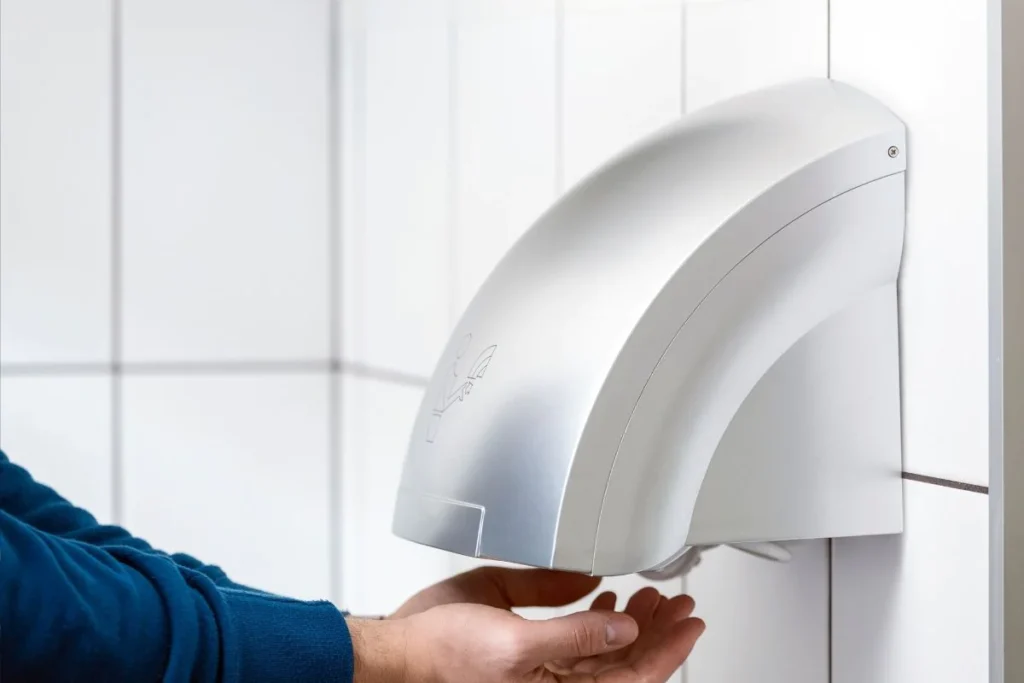Commercial hand dryers are now a staple in most public restrooms worldwide that offer an environmentally friendly and convenient alternative to paper towels. With advancements in technology and increasing consumer expectations, the hand dryer industry is poised for significant growth and innovation.
In this article, we’ll explore the latest trends and innovations that are shaping the future of hand dryers, including energy efficiency, increased hygiene, noise reduction, and customization.
Energy Efficiency
Energy efficiency is a primary concern for consumers and of course manufacturers. Energy efficiency directly impacts the environment and business’s operating costs.
As a result, there is growing demand for hand dryers that consume less power while still being able to maintain a high level of performance. Manufacturers are responding by developing advanced models that incorporate energy-efficient motors and heating systems.
Some hand dryer manufacturers like Xlerator (https://handywashroom.com/hand-dryers/xlerator/) are now using brushless motors and other energy savings technologies like adjustable heat settings which save energy and also cater to individual preferences.
Increased Hygiene

Source: novatech.ind.in
Hygiene is obviously the most critical factor in the design and functionality of hand dryers especially as public health awareness continues to grow. Over the years, hand dryers have been criticized for their potential to spread bacteria which has prompted manufacturers to develop new solutions to address these concerns.
They’ve been quite successful at this too. One such innovation was to incorporate HEPA filters in their dryers which remove over 99% of bacteria and viruses from the air and ensure that only clean air is used to dry hands. Some models have gone as far as using UV-C light to further sterilize the air and surfaces within the dryer which provides an extra layer of protection against pathogens.
Then there are the touch-free hand dryers that minimize the risk of cross-contamination. These are equipped with infrared sensors that detect the presence of the hands and activate the dryer without any actual contact with the unit itself.
The hands-free feature has become increasingly popular especially in the wake of the COVID-19 pandemic because it promotes a cleaner and safer environment for all users and other people in the restroom.
Noise Reduction
As they become more powerful and efficient, they can also become louder which is a concern for many manufacturers, and noise-sensitive environments like hospitals, schools, and libraries. The goal of most manufacturers is to address this issue by developing hand dryers with improved noise reduction technology too.
These innovations include better insulation, reduced air turbulence, and adjustable speed settings. Some models even incorporate noise-dampening materials into the dryer casing, further reducing the sound produced during operation. Their goal is to provide a high-performance hand dryer that users can enjoy the benefits of without sacrificing comfort or disrupting the surrounding environment.
The National Institute of Health published a study that showed although many hand dryers score below 85 dBA (decibels), about a third of the models tested scored above 100 which can damage hearing if exposed to all day (source).
These type of user grievances have compelled manufacturers to take them seriously and create a product that does not only increase hygiene but will not adversely affect the user’s hearing.
Customization Options

Source: hogfurniture.com.ng
For businesses, user customization is becoming very popular with manufacturers offering a wide range of options to cater to different preferences and needs. This includes a variety of finishes and materials such as stainless steel, chrome, and colored plastics which allow users to select a hand dryer that complements the aesthetic of their restroom.
As noted above, some manufacturers offer models with an array of customizable settings like adjustable heat, airspeed, and activation sensors. These options let users to optimize the dryer for their specific requirements and environments while ensuring a satisfactory experience for all.
Trends in hand dryer design
One of the biggest trends in their design is the move towards touchless technology. Many modern hand dryers use infrared sensors to detect the presence of hands, reducing the risk of germ transmission and improving overall hygiene. Additionally, many of these touchless models incorporate a HEPA filter to help remove bacteria and other contaminants from the air.
Another trend is the use of energy-efficient technology. Many of them are designed to use less power than older models, making them more environmentally friendly and cost-effective. This trend has also led to the development of hand dryers that utilize renewable energy sources, such as solar power or wind power.
In terms of aesthetics, they are becoming more customizable and versatile. Many manufacturers offer a range of colors and finishes, allowing organizations to select hand dryers that match their decor or branding. Additionally, some of them are designed to be mounted on walls or placed on countertops, offering more flexibility in terms of placement.
The Future of Hand Dryers

Source: prestigewa.com.au
It’s not easy to see how the modern state of the art hand dryer can get any better but with the continued development of energy-efficient technology, reduced noise levels, and customizable features, hand dryers are poised to become an even more integral part of public restrooms worldwide.
Conclusion
In conclusion, their future is looking bright. Innovations in their technology and design are focused on creating more efficient, hygienic, and customizable options for users and organizations. The move towards touchless technology and the incorporation of HEPA filters are just a couple of examples of how hand dryer design is evolving to meet the needs of the modern world.
Additionally, the focus on energy efficiency and renewable energy sources is making hand dryers more environmentally friendly and cost-effective.
As technology continues to advance, it is likely that hand dryers will become even more sophisticated and capable. Potential future developments include the use of artificial intelligence to analyze user behavior and preferences, as well as the incorporation of virtual reality technology to create more engaging and interactive user experiences.

























